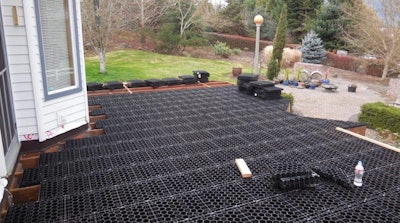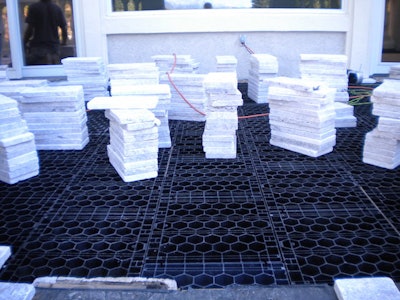
For years, decks, elevated patios and balconies have been popular choices for homeowners when designing or remodeling their outside living spaces. However, until recently, decking options have been limited primarily to wood or composite materials. Natural stone, pavers and tile – while aesthetically appealing – are too heavy and difficult to install on traditional wood joist framing.
However, a new durable, plastic polymer grid system is facilitating the installation of stone up to 3-inches thick on elevated surfaces. Called the Silca System, it's designed to support the structural load across a 16-inch on-center span, which effectively opens up the entire range of stone options for elevated surfaces to include the use of natural stone pavers, travertine, pavers, slate, marble and tile.
“With traditional deck materials, it was nearly impossible to use stone on any elevated surface,” explains general contractor Jim Richardson of Richardson Brothers Construction & Demolition, located in Kendall, N.Y. “I wanted to offer stone decks to my customers, but any underlayment would have trapped moisture. Plus, the joist system would have to be significantly reinforced to support the weight.”
 The Silca System, mid-installation.
The Silca System, mid-installation.
According to Richardson, whose company builds and remodels high-end, custom homes, many of his customers are naturally attracted to stone because it adds substantial value to their homes and increases the aesthetic appeal of the property while requiring little maintenance.
“In my opinion, no composite deck can compare to the beauty of a stone deck,” Richardson adds. “There’s something about the stone that adds style and class and just feels solid.”
Weather also presents concerns for stone materials. Due to freezing and thawing in New York (not to mention other regions that contend with cold weather), installing stone directly on the ground can have unexpected consequences.
“Even with thorough base preparation, the freezing ground, frequent thaws and ground settling make it very difficult to install stone on the ground,” Richardson explains. “As the years pass, pavers tend to heave up and down, requiring further upkeep and maintenance.”
Instead, by elevating the stone, “there is no more heaving, and the grass doesn’t grow between the pavers,” Richardson says.
Richardson adds that the installation of a stone deck with Silca grates is comparable in cost to traditional wood or composite decks, depending on the type of stone used.
“When you compare by square footage, the labor and material for installation, the costs for stone decks are very similar to wood or composite decks,” Richardson says.
 The completed stone decking.
The completed stone decking.
About the System
Designed and manufactured by Sare Plastics, a custom injection molding operation, the Silca System is a deck inlay subflooring grid that can be used on new decks as well as retrofit applications.
Based on the hexagonal structure of beehives and manufactured from engineered polymers into 1 ½-inch- thick grids, the Silca Grates ensure a structural surface for natural stone and manufactured pavers. The system is certified to meet building standards by the ICC.
The Silca Grates are fastened to the deck joists 16 inches on center using four 3-inch deck screws coated for pressure-treated lumber. The grates can easily be cut to any length or contour using a circular, table or reciprocating saw.
“I had never seen anything like it before, but I was amazed at how easy it was to cut and install to match the shape of any elevated structure,” Richardson says. “I can use it to build anything my customer’s desire using stone, slate, or bricks – including two-story decks, two or three-tier decks, stairs. The possibilities are unlimited.” The final project.
The final project.
Milka Pejovic is a technical writer based in San Diego, Calif.











































